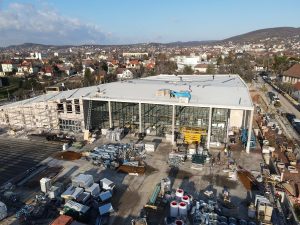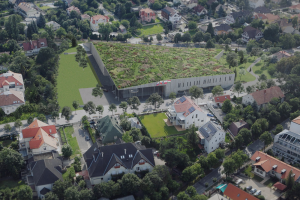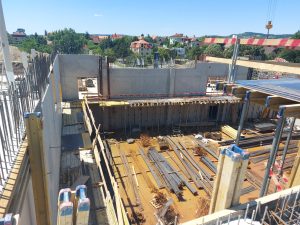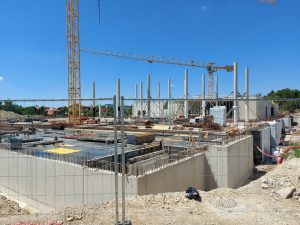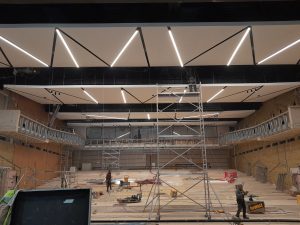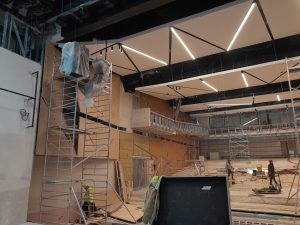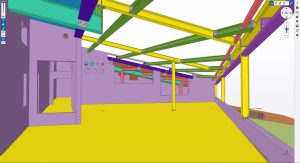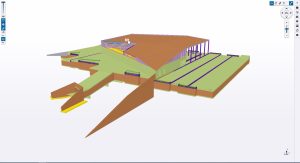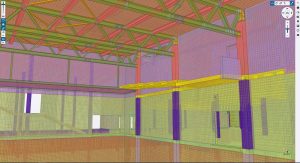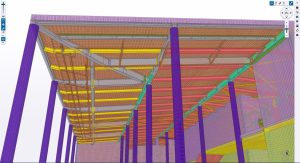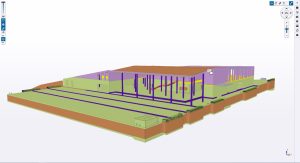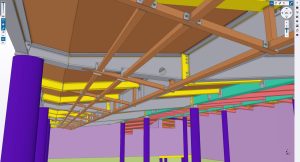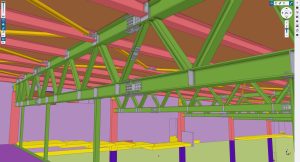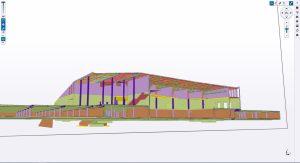V4 Konferencia Központ
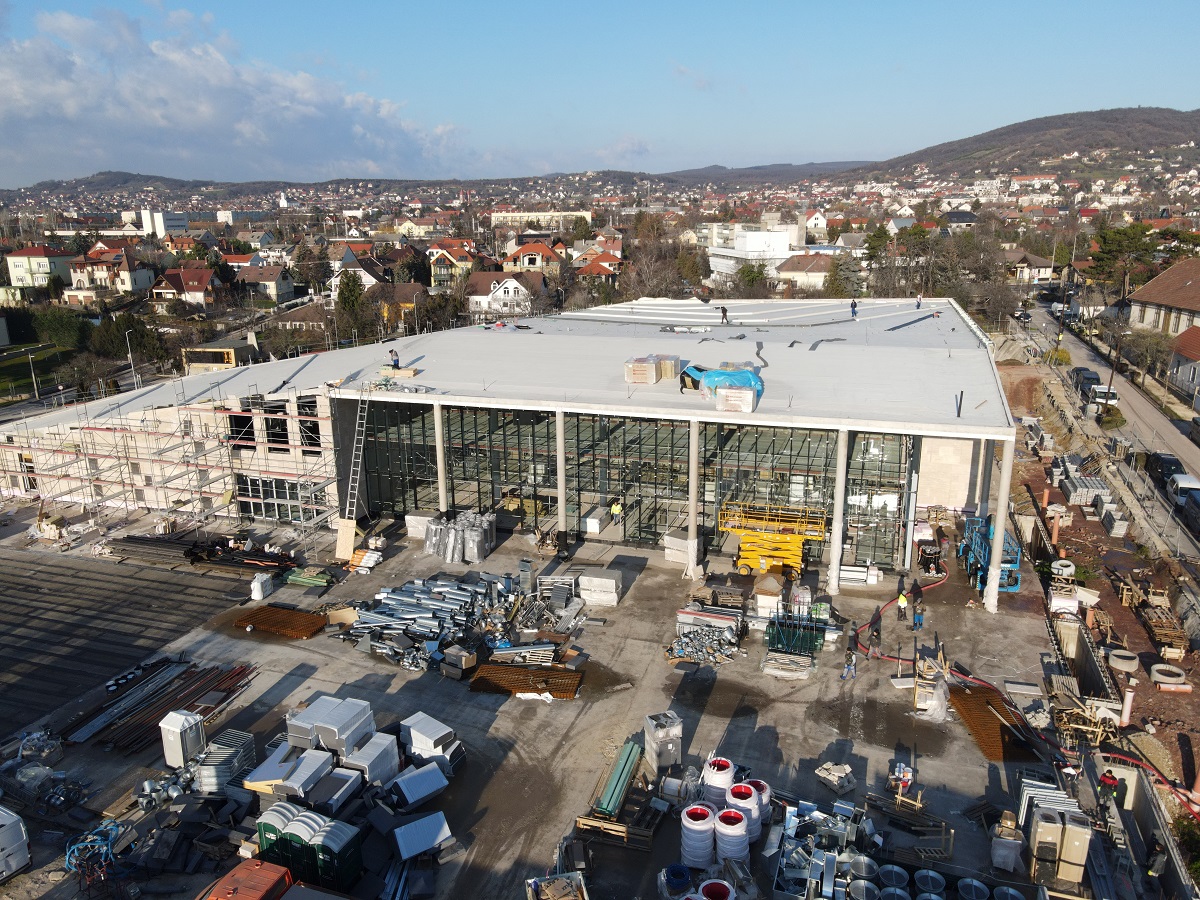
| Categorie | Publieke projecten |
|---|---|
| Jaar | 2023 |
| Land | Hungary |
| Organisatie | CEOS Kft. |
| Projectpartners | KÖZTI Zrt. |
| Auteur | Bisz István, Szabó László |
| Co-auteurs | Borbély János, Szikszai Zsolt, Varga Zoltán |
| Cliënt | Balatonfüred Város Önkormányzata |
| Plaats van constructie | Balatonfüred, Magyarország |
| Tags |
Az épület rendeltetése 2000 személyes bruttó 4500 m2-es, mélygarázsos multifunkcionális konferencia központ. Az alapvetően nagy terekből álló épület képes flexibilisen befogadni nagy rendezvényeket, konferenciákat, vacsorákat. A 650 m2-es előcsarnok a hatalmas üvegfalaival szervesen kapcsolódik az előtte kialakított városi térhez. A két szint magas tér alkalmas kiállítások, állófogadások lebonyolítására. Az épület az ott lévő természetes dombba simul, elrejtve az épületet. Csak a Huray utca irányából tárul fel az épület valódi tömege.
A 120m x 82m befoglaló méretű épület egy dilatációs egységet képez. A pinceszint az épület teljes alapterületét kitöltve mindenhol földbe süllyesztett. A földszint és emeleti szint képez terepszint feletti tömeget. Az alaprajz középső zónájában foglal helyet az épület funkcionális középpontja a konferenciaterem, mely vertikálisan kitölti a teljes épületmagasságot. Vegyes funkciója miatt színpaddal és mozgatható nézőtérrel rendelkezik, melynek gépészeti elemei a pinceszinten vannak. A konferenciaterem teljes alaprajza monolit falakkal határolt, melyek az épület globális merevítésében is jelentős szerepet vállalnak.
Az épület szerkezeti rendszerét tekintve egy szabályos pillérraszterű monolit vasbeton pillérváz, síklemez födémekkel, monolit vasbeton merevítőfalakkal. A pillérraszter általános esetben 8,10 m x 8,1 m. Kivételt képez ez alól a belső konferencia tér, ahol a teljes alaprajzi méretében nyitott és nagyfesztávú térlefedés zárja. Az épület alapozása a kedvező altalaji adottságok miatt lemezalappal megoldható.
A pince feletti födém terheléstől függően több eltérő vastagságú zónára bontható, 65, 50, 36 ill.32 cm vastagsággal, a főbejárat előtti zónában rasztervonalanként lelépcsőzve. Az eltérő vastagságú lemez mezők alsó síkjukkal színelnek. A földszint felett homogénebb teherelrendezés lehetővé teszi az egységes lemezvastagság alkalmazását. A zárófödém könnyűszerkezetes geredarácsra szerkesztett trapézlemezes kompozit födém. A konferenciaterem feletti térlefedést rácsostartókra épített trapézlemezes kompozit födem adja. Az épület függőleges teherviselő elemei monolit vasbeton pillérek és monolit vasbeton falak. A pince határoló falai vízzáró kivitelben készülnek. Említést érdemel a két szintes belmagasságú kiállítótér 7-es raszteri faltartója mely részben a tető támaszául szolgál, részben beköti a 7-L raszterkeresztben lévő „lebegő” felszerkezeti épület sarkot. A tető acélszerkezetű vázszerkezet által alátámasztott kompozit vasbeton födém. A kompozit födémet vasbeton oszlopra helyezett acélgerendák tartják. A plenáris terem nagyobb fesztávú tér kialakítása miatt acélszerkezetű rácsos tartó kialakítása szükséges. A rácsostartókra kerülnek rögzítésre a színháztechnika által megadott pozícióban és terheléssel a szcenikai tartók és a világítástechnikai hidak.
Miért TEKLA ?
A vegyes szerkezeti rendszer és az általános helyzetű síkokkal határolt tetőszerkezet rengeteg különböző szögben találkozó és eltérő anyagú szerkezeti csomópontot eredményezett. Ennek kézbentartására szükség volt egy olyan szoftverre, mely minden területen megoldást kínál – akár vasbetonról, akár acélszerkezetről legyen szó.
Public introduction: https://youtu.be/NiGTrOcIdDk
The purpose of the building is a 2000-person 4500 m2 multifunctional conference center with an underground garage. The building, consisting mainly of large spaces, is capable of flexibly accommodating large events, conferences. The 650 m2 lobby seamlessly connects to the urban square in front of it with its huge glass walls. The double-height space is suitable for exhibitions and receptions. The building is nestled into the natural slope, concealing it. The true mass of the building is only revealed when approached from Huray Street.
The building, with a footprint of 120m x 82m, forms a dilation unit. The basement level is fully submerged in the ground. The ground floor and upper floor create a mass above ground level. In the central zone of the floor plan, the functional centerpiece of the building, the conference hall, occupies a vertical space that spans the entire height of the building. Due to its versatile functionality, it is equipped with a stage and movable seating, with the mechanical elements located in the basement. The conference hall has a monolithic floor plan, enclosed by walls that also play a significant role in the overall structural stability of the building.
In terms of structural system, the building features a regular grid of monolithic reinforced concrete columns, flat slab floors, and monolithic reinforced concrete shear walls. The column grid is generally 8.10m x 8.1m. The internal conference area is an exception, where an open and large-span space covers the entire floor plan. The floor slab above the basement can be divided into several zones of different thicknesses depending on the load, ranging from 65cm, 50cm, 36cm, and 32cm, with step-like variations along the gridlines in front of the main entrance. Slab fields with different thicknesses are leveled at their lower plane.
The more uniform load distribution above the ground floor allows for the application of a consistent slab thickness. The roof is a composite slab supported by a lightweight steel truss framework. The space above the conference hall is covered by a composite slab supported by grid beams. The vertical load-bearing elements of the building are monolithic reinforced concrete columns and monolithic reinforced concrete walls. The basement walls are constructed to be watertight. Worth mentioning is the wall support of the two-story exhibition space, which partly serves as a support for the roof and partly binds the “floating” superstructure corner in the 7-L grid. The roof is a composite reinforced concrete slab supported by a steel framework. The composite slab is supported by steel beams placed on reinforced concrete columns. Due to the larger span of the plenary hall, the use of a steel truss support structure is necessary. The trusses are used for attaching the theatrical equipment, stage supports, and lighting bridges.
Why TEKLA
The mixed structural system and the roof structure bounded by general position planes resulted in a large number of structural nodes meeting at different angles and of different materials. To handle this complexity, a software was needed that could provide a solution for all areas – whether reinforced concrete or steel structures.
Public introduction: https://youtu.be/NiGTrOcIdDk
